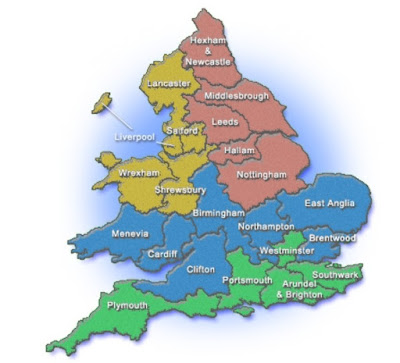As alluded to in a post last month, an anticipated slice of good news – for those attached to the Usus Antiquior in the Archdiocese of Liverpool – seems to have arrived.
His Grace The Archbishop of Liverpool, Most Rev. Malcolm McMahon, has invited into the Archdiocese the Priestly Fraternity of St Peter (FSSP) – a Traditionalist Catholic clerical Society of Apostolic Life, enjoying Pontifical Right, canonically established by Pope St. John Paul II in the tumultuous summer of 1988 under the papal motu proprio Ecclesia Dei adflicta.
Specifically, they will be joining a "cluster" of parishes at Warrington, Cheshire, halfway between the cities of Liverpool and Manchester on the southern border of the Liverpool archdiocesan area (below).
"Parish clusters" – however they are arrived at – are a sign-of-the-times across many parts of the western Catholic world: not unusually one parish priest is to oversee two, or three, closely located, or otherwise connected, parishes in order to provide each church with at least the minimum pastoral care and Mass provision. The cluster into which the FSSP has been invited at Warrington is that of St Mary, St Benedict and St Oswald, all of which owe their founding heritage to the Order of Benedictine monks at Ampleforth Abbey who established a mission, from the mid-18th century, in the town, eventually covering four parish locations.
The Archbishop wishes the Fraternity to have "responsibility" for the church of St Mary (n.b. not the parish – a distinction His Grace is keen to make).
It is heartening, then, that the archdiocese should soon boast another location for the celebration of the Old Mass (and sacraments, as is crucial to also note). And a very fine one, too.
This good development should surely restore some confidence amongst those attached to Tradition in this archdiocese who, as we have previously stated, had become more than a little wary (not without justification, as future posts will show) about the direction of matters, certainly as regards the area provision of the Extraordinary Form of Mass, in the short period (since May 2014) under His Grace's shepherding of the Liverpool flock. Deo gratias! It almost goes without saying that it will bolster the belief of those local Traditionalists who have always remained optimistic as to the future of the Old Rite in this area under Archbishop McMahon. As stated previously, we again make the point that Traditionalists in this archdiocese have become split about what the future holds – and not just regarding the matter of the Old Rite of Mass and sacraments – under His Grace.
Taking our lead from His Grace's very nuanced statement, we should highlight that whomever the FSSP sends to Warrington he will not be the parish priest. As the Archbishop stressed, that will be Fr David Heywood – who will have jurisdiction across all three parishes – who replaces the outgoing Mgr John Devine OBE who is to move to the Isle of Man. Further, it would seem that, regardless of whether the incoming FSSP priest(s) would live in residence at St Mary (it would be sensible) this would still not have any influence on their having "pastoral responsibility" for those in the parish.
It's a very fine point, and we confess that we're not exactly sure what the motivation is for this (presumably juridical) distinction and what it may mean practically, day-to-day. We therefore reserve just a small note of prudent caution. Indeed, it may perhaps prove to be a positive for Traditionalists who will avail themselves of the FSSP mission in Warrington. Anyway, it is at least clear for now that the FSSP will certainly have "responsibility" for the church of St Mary. So good.
It would appear that there are similarities and differences between what is envisaged at Warrington and what has successfully been implemented, for example, at New Brighton or Preston. At both of those locations, the Institute of Christ the King Sovereign Priest – another Society of Apostolic Life enjoying Pontifical Right, established in 1990 also according to Ecclesia Dei adflicta – was invited into the Dioceses of Shewsbury and Lancaster respectively, by the Ordinaries in both, the Rt Revv. Bishops Mark Davies and Michael Campbell respectively.
At New Brighton (on the edge of Shrewsbury diocese, on the opposite bank of the River Mersey directly facing the southern borders of the Archdiocese, and City, of Liverpool) ICKSP are sole custodians of the shrine church and former parish of St Peter & Paul and Philomena (the latter saint was added to the shrine's titular patronage after ICKSP's arrival). As a shrine, dedicated to Eucharistic Adoration, it is accurate that New Brighton is not strictly "a parish". That said, it is understood sensibly by all that no priests other than those of ICKSP – who directly and immediately serve the invitation of Bishop Davies – hold any responsibility, pastoral or otherwise, for any matters at New Brighton. Likewise ICKSP has a similar arrangement in Lancaster diocese, another of the Archdiocese of Liverpool's immediate neighbours, this time to the north, where they are solely responsible for the church and former parish of St Walburge, which is now also a shrine centre devoted to Eucharistic Adoration, and which is, incidentally, but a few streets' walk from the northernmost boundary of Archbishop McMahon's neighbouring territory (within which there is a similar Novus Ordo shrine dedicated to exposition of the Blessed Sacrament, right in the heart of Liverpool's city centre shopping district, run by the fathers [SSS] of the Congregation of the Blessed Sacrament). It would seem, though, that no especial arrangement has been made with the FSSP at Warrington other than their generous provision of the Extraordinary Form of Mass and Old Rite sacraments and that ultimate responsibility for the parish will rest with Fr Heywood.
We only stress these, perhaps pedantic, distinctions because perhaps, at this point, it is necessary to do so.
Interestingly, all three of the churches/shrines mentioned above that are now to be overseen by Traditionalist priests – St Mary (Warrington), St Peter & Paul and Philomena (New Brighton) and St Walburge (Preston) – share a common recent experience. They are all hugely monumental listed buildings (St Walburge's being Grade I status, with New Brighton and Warrington being Grade II) and therefore all possessing significant demands of maintenance. All of them were facing very uncertain futures during the last decade, chiefly (though not exclusively) due to falling Mass attendances. The New Brighton church, for instance, had been closed for several years prior to the rejuvenating arrival of ICKSP in late 2011, whilst St Walburge's was in the final year of a seven year "stay of closure" that was initiated in 2008 and due to be enacted in 2015 but which was offset by ICKSP's very timely appearance in 2014. The uncertainties over St Mary, in Warrington – boasting Pugin-family architecture no less (Edward Welby Pugin and Peter Paul Pugin) which was both founded (1875) and served by the English Benedictine Congregation's monks at Ampleforth Abbey (York) – began in 2012 when the founding Order of the parish said it would be withdrawing from the location simply because it could no longer spare a monk to serve it. The same happened elsewhere that year in the Archdiocese of Liverpool when the Benedictines also had to withdraw from St Austin's parish in the city's suburbs. Like at Warrington, the Archdiocese of Liverpool immediately assumed responsibility for the St Austin parish and really had little choice but to do so.
All of this outlines a very sobering era for the Church locally and across the north west of England, not to mention nationally and internationally across the West. It is perhaps telling, though, that in each of the three regional cases mentioned here, it has been the Traditional priestly societies, whose numbers are steadily rising year-on-year, who have been approached to step-into-the-breach. The FSSP, for instance, last month celebrated the ordination of 14 new priests from across its three international seminaries (some truly marvellous photographs here – on Rorate Caeli – and a request for prayers for all of the fine men featured). Meanwhile, just two days ago, at the time of writing, ICKSP celebrated the ordination – by His Eminence Cardinal Raymond Burke – of 11 priests, seven deacons and nine sub-deacons (pray also for the courageous men named in the Rorate Caeli pre-report).
So, there is to be a new and very welcome dawn in Warrington under the FSSP's safe-handling. However, it is not before time. For the reality is that, due to St Mary's renowned and generally retained liturgical splendour and heritage (with little post-conciliar re-ordering) – with a particular excellence in music – the FSSP originally offered (at the request of several parishioners, inspired by the vision of Pope Benedict XVI's 2007 motu proprio Summorum Pontificum) to step in and serve there when the Benedictines left in 2012. Sadly it was a gesture declined...for whatever reason (there is little point revisiting that – we say, ugly – matter now). Therefore, it is heartening to note – and it should be emphasised strongly – that a different tenor seems to be sounding across the Archdiocese of Liverpool regarding relations with the Traditional priestly societies. For that we surely have the "new" Archbishop to thank, now some 14 months into his tenure. Indeed, according to our sources, in the earliest days after Archbishop McMahon arrived in Liverpool in May 2014, a group of parishioners submitted a repeat petition for the Fraternity (or certainly a Traditional priestly society) to take over the church. Thanks be to the Holy Ghost they have been successful second time around (and we know that this has definitely been the result of perseverance in prayer by those involved for this precise outcome – so an object lesson for us all there). Whilst there can be little doubt that some aspects of His Grace's decision must surely have been grounded in pragmatism, and perhaps even expediency – it would be foolish to think otherwise – it is nevertheless a mark of sound shepherding to make the right decision when it is called for. And this is undoubtedly the correct call for all involved at St Mary, Warrington and the archdiocese.
That His Grace is clearly not averse to maintaining contact with the Traditional priestly societies – as evidentially borne out in this instance, but we know, anyway, from our own information that this is so – and that he has clearly acted in this instance with an obviously and sensitively implied intention to preserve the liturgical orthodoxy for which St Mary has long been renowned, is a great encouragement. It would be uncharitable not to recognise this.
Therefore, another positive for us to record. But – as per the cautious tone across our initial posts on this fledging blog – we still must rank His Grace's very welcome decision as another mixed signal about what his overall pastoral intentions for this archdiocese are.
This is not a "never satisfied" churlishness. For as our promised future posts will surely show (which we will craft with care and charity), there still remain many grounds for significant confusion and fear. There really shouldn't be any at all.
We join all those who rightfully rejoice at the news concerning Warrington.
We also stand by our decision to remain circumspect.







